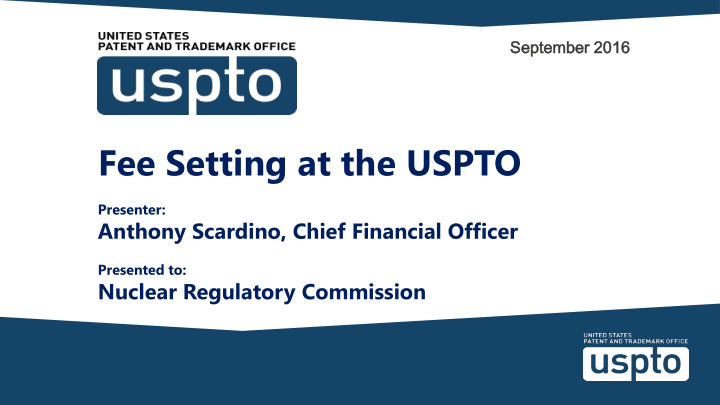



September Se ptember 20 2016 16 Fee Setting at the USPTO Presenter: Anthony Scardino, Chief Financial Officer Presented to: Nuclear Regulatory Commission
What is the USPTO? Mission : Fostering innovation, competitiveness and economic growth, domestically and abroad by delivering high quality and timely examination of patent and trademark applications, guiding domestic and international intellectual property policy, and delivering intellectual property information and education worldwide, with a highly skilled, diverse workforce. 2
What is the USPTO’s Funding Model? The USPTO operates like a business: • − Stakeholders request products/services and expect them to be delivered in accordance with established performance metrics. − Costs are funded from the revenue derived from patent and trademark fees. − Leverage “business tools”, like an operating reserve. 3
How Much Does the USPTO Collect in Fees? Historical Trends - Total Collections $3,500 $3,000 $2,500 $2,000 Millions $1,500 $1,000 $500 $0 2001 2002 2003 2004 2005 2006 2007 2008 2009 2010 2011 2012 2013 2014 2015 2016* Patent Fee Collections Trademark Fee Collections *The FY 2016 estimate is from the FY 2017 President’s Budget
What is the History of Fee Setting at the USPTO? 1980: Public Law 96-517 – Establishes patent renewal (maintenance fees) due at three • time periods (stages). 1982: Public Law 97-247 – Establishes the patent small entity discount for all fees set • by Congress and the Trademark “fence” (Trademark user fees may be used only on trademark related operations). 1990: Public Law 101-508 – A 69% surcharge is applied to all patent statutory fees. • The agency becomes fully-fee funded. 1991: Public Law 102-204 – Establishes yearly adjustments to patent statutory fees • based on annual increases to CPI. 2005: Public Law 108-447 – Establishes the current USPTO fee structure, including • separate patent filing, search and examination fees and discounts for trademark applicants who file electronically and agree to other terms. 2011: Public Law 112-29 (America Invents Act) – Establishes USPTO’s authority to set • most patent and trademark fees such that aggregate revenue from the fee schedule recovers aggregate costs. Establishes additional small entity fees and new micro entity fees. 5
The AIA and USPTO Fee Setting • Section 10 of the AIA authorizes the Director of the USPTO to set or adjust by rule all patent and trademark fees established, authorized, or charged under Title 35 of the U.S. Code and the Trademark Act of 1946 (15 U.S.C. § 1051 et seq.), respectively. Authority terminates 7 years after enactment (9/15/2018) o Requires setting fees at rates that, in the aggregate, will recover aggregate costs o 6
Fee Structure Unique Features of the USPTO’s Fee Structure Fee collections, in aggregate, are intended to recover USPTO • operating costs. Entry fees are set low to minimize barriers to entry into the IP • system. Fees further along in the process subsidize initial operational costs. • Discounted fees (50% and 75%) for major patent actions are • available to applicants who meet small and micro entity definitions. Discounted trademark fees are available to trademark applicants • who file applications electronically and agree to other terms. 7
Guiding Principles Guiding Principles What is the USPTO’s Philosophy? Self-Sustaining Transparent Streamlined Balanced Dynamic Agile Goal Provide sufficient financial resources to facilitate the effective administration of the United States intellectual property system. Explanation of Objectives Objectives Promoting competitive markets that spur productive entrepreneurship; Promote Administration Fostering innovation that will lead to technologies of the future; and Innovation Encouraging high-growth and innovation-based small business entrepreneurship. Strategies * Small entrepreneur subsidy * Easy entry * Certain amount of back-end subsidy * Analyzing the full cost of USPTO processes compared to the fee amount. Align fees with the Aggregate fees should recover the full prospective cost of aggregate costs of the patent or trademark business. full cost of products Total fees should be sufficient to address workload input on a steady-state basis, plus the necessary costs to achieve strategic objectives and services. such as reducing the backlog, process improvements, multi-year initiatives, capital improvements, and maintain an operating reserve. Submitting applications or taking actions which help to facilitate efficient processing; Set fees to facilitate the effective Encouraging the prompt conclusion of application prosecution; or administration of Recovering costs for actions that are strenuous on the patent and trademark systems (i.e., increased fees for certain rework, the patent and large applications, missing parts). trademark systems. Setting fees for certain processes that provide special (unique) value or advantages for the applicant. Offer application Includes processing choices such as prioritized examination (Track 1) and streamlined reexamination. processing options. “Innovation IP Protection Jobs Economic Growth” 8
What are the Components of Fee Setting at the USPTO? Production Workloads Economic Historical ABI Cost Analysis USPTO Fee Structure Fee Setting Legal & Budget Policy Formulation Analysis Strategic Planning 9
Why is ABI a Major Fee Setting Component? • Activity-Based Information (ABI) uses financial and workload data to determine the full cost of activities performed at USPTO (including overhead) as well as the full cost of products and services offered at the agency. • ABI information is useful to both internal and external groups interested in how the organization uses its resources to meet its objectives. C OST O BJECTS R ESOURCES A CTIVITIES R ESOURCE D RIVERS A CTIVITY D RIVERS What was produced? What was spent? What did we do? Who benefited? 10
What is the AIA Fee Setting Process? PAC Fee Setting Hearing PAC Report Published Prepare Notice Calculate DOC/OMB Biennial Fee of Proposed Aggregate Cost Review of Review Rulemaking and Revenue NPRM (NPRM) Public Delayed Prepare Final DOC/OMB Comment on Effective Date Rule (FR) Review of FR NPRM of FR NPRM Published in Fed. Reg. FR Published in Fed. Reg.
Closing Thoughts Challenges and Lessons Learned 12
Recommend
More recommend